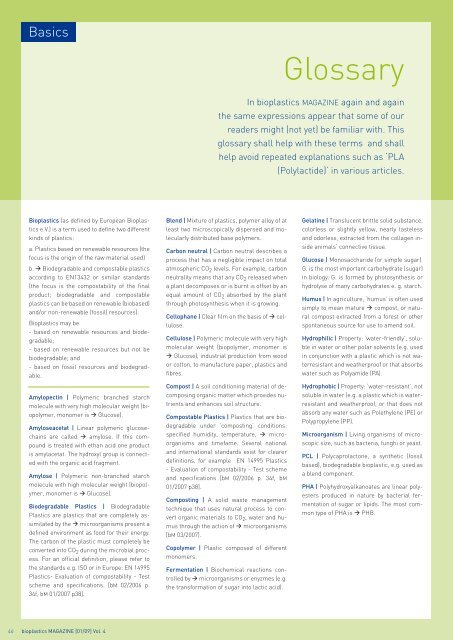bioplasticsMAGAZINE_0901
bioplasticsMAGAZINE_0901
bioplasticsMAGAZINE_0901
Create successful ePaper yourself
Turn your PDF publications into a flip-book with our unique Google optimized e-Paper software.
Basics<br />
Glossary<br />
In bioplastics MAGAZINE again and again<br />
the same expressions appear that some of our<br />
readers might (not yet) be familiar with. This<br />
glossary shall help with these terms and shall<br />
help avoid repeated explanations such as ‘PLA<br />
(Polylactide)‘ in various articles.<br />
Bioplastics (as defined by European Bioplastics<br />
e.V.) is a term used to define two different<br />
kinds of plastics:<br />
a. Plastics based on renewable resources (the<br />
focus is the origin of the raw material used)<br />
b. à Biodegradable and compostable plastics<br />
according to EN13432 or similar standards<br />
(the focus is the compostability of the final<br />
product; biodegradable and compostable<br />
plastics can be based on renewable (biobased)<br />
and/or non-renewable (fossil) resources).<br />
Bioplastics may be<br />
- based on renewable resources and biodegradable;<br />
- based on renewable resources but not be<br />
biodegradable; and<br />
- based on fossil resources and biodegradable.<br />
Amylopectin | Polymeric branched starch<br />
molecule with very high molecular weight (biopolymer,<br />
monomer is à Glucose).<br />
Amyloseacetat | Linear polymeric glucosechains<br />
are called à amylose. If this compound<br />
is treated with ethan acid one product<br />
is amylacetat. The hydroxyl group is connected<br />
with the organic acid fragment.<br />
Amylose | Polymeric non-branched starch<br />
molecule with high molecular weight (biopolymer,<br />
monomer is à Glucose).<br />
Biodegradable Plastics | Biodegradable<br />
Plastics are plastics that are completely assimilated<br />
by the à microorganisms present a<br />
defined environment as food for their energy.<br />
The carbon of the plastic must completely be<br />
converted into CO 2 during the microbial process.<br />
For an official definition, please refer to<br />
the standards e.g. ISO or in Europe: EN 14995<br />
Plastics- Evaluation of compostability - Test<br />
scheme and specifications. [bM 02/2006 p.<br />
34f, bM 01/2007 p38].<br />
Blend | Mixture of plastics, polymer alloy of at<br />
least two microscopically dispersed and molecularly<br />
distributed base polymers.<br />
Carbon neutral | Carbon neutral describes a<br />
process that has a negligible impact on total<br />
atmospheric CO 2 levels. For example, carbon<br />
neutrality means that any CO 2 released when<br />
a plant decomposes or is burnt is offset by an<br />
equal amount of CO 2 absorbed by the plant<br />
through photosynthesis when it is growing.<br />
Cellophane | Clear film on the basis of à cellulose.<br />
Cellulose | Polymeric molecule with very high<br />
molecular weight (biopolymer, monomer is<br />
à Glucose), industrial production from wood<br />
or cotton, to manufacture paper, plastics and<br />
fibres.<br />
Compost | A soil conditioning material of decomposing<br />
organic matter which provides nutrients<br />
and enhances soil structure.<br />
Compostable Plastics | Plastics that are biodegradable<br />
under ‘composting’ conditions:<br />
specified humidity, temperature, à microorganisms<br />
and timefame. Several national<br />
and international standards exist for clearer<br />
definitions, for example EN 14995 Plastics<br />
- Evaluation of compostability - Test scheme<br />
and specifications [bM 02/2006 p. 34f, bM<br />
01/2007 p38].<br />
Composting | A solid waste management<br />
technique that uses natural process to convert<br />
organic materials to CO 2 , water and humus<br />
through the action of à microorganisms<br />
[bM 03/2007].<br />
Copolymer | Plastic composed of different<br />
monomers.<br />
Fermentation | Biochemical reactions controlled<br />
by à microorganisms or enyzmes (e.g.<br />
the transformation of sugar into lactic acid).<br />
Gelatine | Translucent brittle solid substance,<br />
colorless or slightly yellow, nearly tasteless<br />
and odorless, extracted from the collagen inside<br />
animals‘ connective tissue.<br />
Glucose | Monosaccharide (or simple sugar).<br />
G. is the most important carbohydrate (sugar)<br />
in biology. G. is formed by photosynthesis or<br />
hydrolyse of many carbohydrates e. g. starch.<br />
Humus | In agriculture, ‘humus’ is often used<br />
simply to mean mature à compost, or natural<br />
compost extracted from a forest or other<br />
spontaneous source for use to amend soil.<br />
Hydrophilic | Property: ‘water-friendly’, soluble<br />
in water or other polar solvents (e.g. used<br />
in conjunction with a plastic which is not waterresistant<br />
and weatherproof or that absorbs<br />
water such as Polyamide (PA).<br />
Hydrophobic | Property: ‘water-resistant’, not<br />
soluble in water (e.g. a plastic which is waterresistant<br />
and weatherproof, or that does not<br />
absorb any water such as Polethylene (PE) or<br />
Polypropylene (PP).<br />
Microorganism | Living organisms of microscopic<br />
size, such as bacteria, funghi or yeast.<br />
PCL | Polycaprolactone, a synthetic (fossil<br />
based), biodegradable bioplastic, e.g. used as<br />
a blend component.<br />
PHA | Polyhydroxyalkanoates are linear polyesters<br />
produced in nature by bacterial fermentation<br />
of sugar or lipids. The most common<br />
type of PHA is à PHB.<br />
46 bioplastics MAGAZINE [01/09] Vol. 4


















